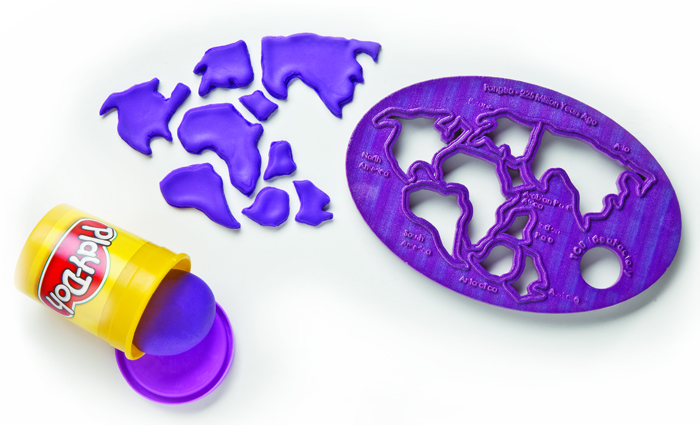Object lesson: Playtectonics
Incorporating entrepreneurial skills into a science class, a chemistry professor and his students develop a middle-school teaching aid.

Six TCU science majors have developed a Pangea cookie cutter teaching aid and educational placemat they call Playtectonics. (Photo by Gary Logan)
Object lesson: Playtectonics
Incorporating entrepreneurial skills into a science class, a chemistry professor and his students develop a middle-school teaching aid.
Think back to middle school and you probably remember learning how the Earth’s continents once connected together like a puzzle. The shapes of South America and Africa, in particular, seem to be a perfect fit.
The hypothesis that the continents were joined then slowly pulled apart was first put forward by Dutch cartographer Abraham Ortelius in 1596 and was fully developed by German meteorologist Alfred Wegener in 1912. By 1926, he had coined the name Pangea for the ancient supercontinent that existed about 225 million years ago, during the Paleozoic and Mesozoic eras.
Hey, shift happens. As geological evidence emerged in the 1960s to support theories of plate tectonics, the scientific community caught the drift, and eventually, it became a staple of junior-high science classes.
But how might a classroom of young students best learn these concepts? Chemistry professor Eric Simanek and six TCU science majors think they have developed a helpful teaching aid — a Pangea cookie cutter and educational placemat they call Playtectonics.
Here’s how it works: Middle-schoolers pound a glob of clay or Play-Doh into a thin oval, and then mash the 8-inch resin-composite cutter down to create continent-shaped slices. One side of the accompanying placemat illustrates how the pieces fit together and discusses the fossil, glacial and geological evidence supporting the theory. The opposite side touches on how the search for evidence derived from many other areas of science, such as seismology, oceanography, physics and chemistry, and why the hypothesis was met bitterly at first by the established geological community.
Quick response (QR) codes on the mat link to animations of plate movement, video interviews with scientists, puzzles, quizzes and other learning materials to test how well students understand the content.
The product addresses a real-world concern, too. Plate tectonics is a concept required under Texas Essential Knowledge and Skills, a checklist of subjects all students must master.
Simanek and his team tested Playtectonics in eighth-grade classrooms in Fort Worth in the spring. The result? Teachers and students raved about the hands-on learning, saying it dramatically helped them understand continental drift better than if they had covered the subject in a book chapter. A few students at McLean Middle School even developed an interpretive dance and performed it for the class.
Amazingly, Playtectonics didn’t exist in January. The idea grew out of Simanek’s “Chemistry and Commercialization” course, in which he laid down a challenge upon its first meeting: Create an educational outreach initiative that can be mass-produced and delivered to the marketplace. The idea was up to them.
Initially, the group considered a cookbook that doubled as a textbook, but cooking eventually became cookies, and by the time the class broke, the basis for a Pangea cookie cutter was in place.
During the next 11 weeks, Simanek and the science students developed a business plan through the Neeley Entrepreneurship Center, which they entered in the business school’s “Values and Ventures” competition, and consulted with a host of cross-disciplinary mentors.
Geologists signed off on the content, graphic designers honed the creative appeal, an e-commerce specialist consulted on an online sales strategy, a rapid prototype developer aided the creation of the cutter mold and Fort Worth school district officials arranged for testing and assessment.
The College of Science and Engineering recognized the effort by establishing the TCU IdeaFactory, an initiative to enlarge the challenge to students campus-wide: create similar education aids and advance them toward commercialization. Teams can earn up to $25,000.
Playtectonics and Simanek’s course itself are outcomes of grant money from the National Science Foundation. Simanek was recently awarded almost $300,000 to determine how QR codes can impact science education. He’s assembled a diverse team, including Molly Weinburgh of the Andrews Institute of Math and Science and Judy Groulx and Sherrie Reynolds from the College of Education.
As the fall semester begins, Playtectonics has a provisional patent and the group is manufacturing 5,000 units, all in TCU purple, for distribution before the end of the year.
Meanwhile, Simanek, ever the cross-disciplinary adventurer, is teaming with professors from geology and classical and contemporary dance to expand the middle schoolers’ interpretive dance, basing it on moving continents and the life of Wegener. They’ll perform it at McLean Middle School in November.
On the Web:
ideafactory.tcu.edu
Video:

Your comments are welcome
1 Comment
We purchased this material 2-3 years ago and we are trying to find the Teacher Resource Materials. The QR codes on the activity maps no longer work and the links in the Teacher’s guide no longer work. Please send the resources or updated links and QR codes.
Related Reading:
Features
Infographic: Minors
A wide variety of minors gives TCU students the chance to add depth to their majors or dive into new areas.
Features
Venture Capitalism 101
MBA students connect investors and startups in a Neeley program.